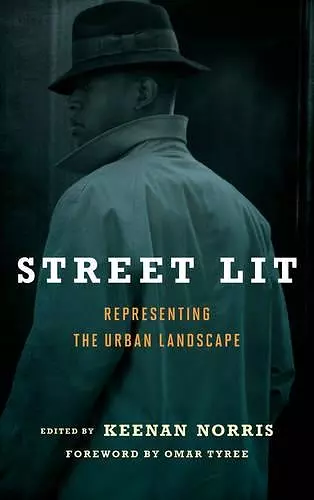Street Lit
Representing the Urban Landscape
Format:Hardback
Publisher:Scarecrow Press
Published:15th Nov '13
Currently unavailable, and unfortunately no date known when it will be back

Over the last few decades, the genre of urban fiction—or street lit—has become increasingly popular as more novels secure a place on bestseller lists that were once the domain of mainstream authors. In the 1970s, pioneers such as Donald Goines, Iceberg Slim, and Claude Brown paved the way for today’s street fiction novelists, poets, and short story writers, including Sister Souljah, Kenji Jasper, and Colson Whitehead. In Street Lit: Representing the Urban Landscape, Keenan Norris has assembled a varied collection of articles, essays, interviews, and poems that capture the spirit of urban fiction and nonfiction produced from the 1950s through the present day. Providing both critical analyses and personal insights, these works explore the street lit phenomenon to help readers understand how and why this once underground genre has become such a vital force in contemporary literature. Interviews with literary icons David Bradley, Gerald Early, and Lynel Gardner are balanced with critical discussions of works by Goines, Jasper, Whitehead, and others. With an introduction by Norris that explores the roots of street lit, this collection defines the genre for today’s readers and provides valuable insights into a cultural force that is fast becoming as important to the American literary scene as hip-hop is to music. Featuring a foreword by bestselling novelist Omar Tyree (Flyy Girl) and comprised of works by scholars, established authors, and new voices, Street Lit will inspire any reader who wants to understand the significance of this sometimes controversial but unquestionably popular art form.
Norris and contributors (academics, authors, poets, editors, musicians, and a lawyer) broaden the definition of urban literature while drawing a distinction between African American and hip-hop literature and emphasizing the differences between classic African American literature and street literature. This title offers a course in the genre in 16 signed essays with references and bibliographies; six poems by Tristan Acker, Debra Busman, Sterling Warner, Arisa White, and Juan Delgado; and interviews with authors Lynel Gardner, David Bradley, and Ethan Iverson. The poems are each one to two pages long, the essays four to 18 pages, and the interviews two to 16. A few black-and-white photos appear in Ana Lúcia Souza and Jacqueline Lima Santos’s essay on Brazilian hip-hop. A cumulative bibliography and detailed index round out the presentation. VERDICT Since it is a relatively new literary genre, little expository material has been published on urban or street literature, making this affordable title of interest to literature students at the undergraduate and graduate levels. * Library Journal *
Norris provides an introductory survey of the new, fast growing genre of street lit—also referred to as urban fiction, hip-hop lit, and gangsta lit. It is made up of edgy stories focusing on personal relationships and survival of the fittest. In this volume Norris provides readers with articles, essays, interviews, and poems that capture the spirit of this edgy literature. Making its appearance in the 1950, the genre draws readers who tend to be young, African American, and female. Urban fiction is characterized by stories of life on the streets and in the projects using brutal descriptions of drugs, violence, sex, abuse, and prison. The work begins with an introduction that explores the roots of this literature and provides insight into how it captures today’s culture in much the same way that hip-hop music does for the music industry. The author provides critical discussions of works by Goines, Japer, and Whitehead, and gives interviews with such literary icons as David Bradley, Gerald Early, and Lynel Gardner. Norris helps scholars, avid readers, and librarians understand the significance of this sometimes controversial but up-and-coming form of literature. * American Reference Books Annual *
The foreword alone, by Omar Tyree, makes this book a must for fans both 'true to the game' (as streetlit vernacular would state) of the genre and 'new to the game' alike. Street Lit: Representing the Urban Landscape serves as a history lesson of the genre in its various forms, tracing the trajectory of slave narratives from the Donald Goines and Iceburg Slim era to the days of Flyy Girl (1993) and The Coldest Winter Ever (1999) to today’s vociferous offerings from the powerhouse urban-literature publishers Triple Crown and Urban Books.The book is made up of essays deftly divided into three sections that invite discussion and reflection: 'Street Literature in America, Past and Present'; 'Early Street Lit, 1950s–1970s'; and 'Contemporary Street Lit, 1990s and 2000s.' These essays take a hard, honest look at the way street lit is marketed, packaged, promoted, and perceived by its intended audience and by those on the outside looking in on a slice of modern street life. The book includes an index as well as an extensive bibliography of articles and accessible book lists of notable works that best represent this popular genre. Although the content is aimed at an academic library audience, this would make a good choice for public library literary criticism shelves, and librarians interested in developing street-lit collections will want to add this title to their professional reading lists. * Booklist *
ISBN: 9780810892620
Dimensions: 237mm x 155mm x 22mm
Weight: 485g
244 pages